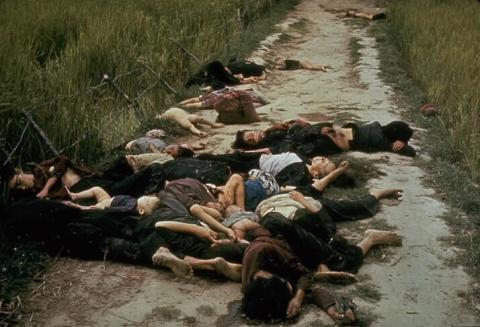
Bodies of civilians, mostly women and children, are strewn in a road after the My Lai massacre on March 16, 1968. Some are visibly bloody and the youngest child is probably no older than 1. In 1968, U.S. forces considered the My Lai area to be a stronghold of Communist Vietnamese fighters (known as Vietcong) and their sympathizers. Repeated bombing of the region only increased the support of local civilians for the Communist fighters. After an order was given to U.S. troops to attack My Lai Village, American soldiers brutally killed hundreds of people, mostly women, children, and elderly. Photographs and reports about the atrocities at My Lai raised opposition to the Vietnam War among many Americans who previously had thought little about it. According to Camilla Griggers, professor of Visual Communication and Linguistics at California State University, Channel Islands: The Army photographer, Ronald Haeberle, assigned to Charlie Company on March 16th, 1968 had two cameras. One was an Army standard; one was his personal camera. The film on the Army owned camera, i.e., the official camera of the State, showed standard operations that is “authorized” and “official” operations including interrogating villagers and burning “insurgent” huts. What the film on the personal camera showed, however, was different. When turned over to the press and Government by the photographer, those “unofficial” photographs provided the grounds for a court martial. Haeberle’s personal images (owned by himself and not the US Government) showed hundreds of villagers who had been killed by U.S. troops. More significantly, they showed that the dead were primarily women and children, including infants. These photographs exposed the fact that the “insurgents” in popular discourse about Vietnam were actually unarmed civilians. The photos made visible to viewers that the “enemy” in Vietnam was actually the indigenous Vietnamese population. (Camilla Benolirao Griggers, “War and the Politics of Perception,” chapter 1 from the essay Visualizing War.) This photograph has been published many times in a variety of formats. This version was taken from the Krysstal website, which has additional, more graphic photographs.
Public Domain
Haeberle, Ronald L. [Bodies of Civilians in My Lai Massacre]. 1968. Photograph. KryssTal. http://www.krysstal.com/democracy_vietnam_mylai.html (Accessed December 17, 2018).
